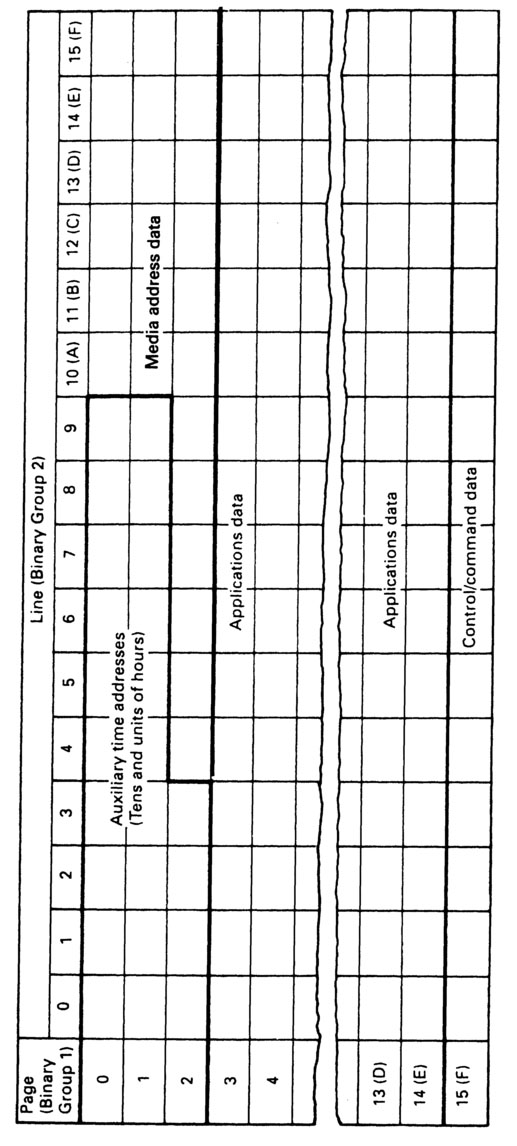Appendix 5
The extended use of binary groups
In 1993 the SMPTE published a standard (SMPTE 262M:1993) and recommended practices (SMPTE RP 173:1993 and RP 179:1994) for the extended use of binary groups to carry an additional timecode, media address data and applications data. The general principle is of grouping several timecode frames of binary groups together to form a 'directory', organized into 'pages' and Tines'. This use of binary groups is flagged in BGF 0-2, with BGFO at '1', BGF1 at '0' and BGF2 at '1'. Table A5.1 illustrates the binary group flag values for LTC and VITC in 24, 25 and 30 fps systems. Data caii be organized into bytes to carry 8-bit character sets, with binary groups 1 and 2 forming byte 1, groups 3 and 4 forming byte 2, groups 5 and 6 forming byte 3, and groups 7 and 8 forming byte 4.
Binary groups 7 and 8 form a directory index, with group 7 specifying a directory line of 16 lines per page and group 8 specifying a directory page of 16 pages. Figure A5.1 illustrates the page-line directory.
All address data in pages 0, 1 and 2 relate to programme timing. Auxiliary time address data are stored in lines 0-9 of pages 0 and 1, and lines 0-3 of page 2 in the following manner:
| LTC bits | VITC bits | Binary group | Assignation |
| 4-7 | 6-9 | 1 | Units of frames |
| 12-13 | 16-17 | 2 | Tens of frames |
| 14 | 18 | 2 | Drop frame flag |
| 15 | 19 | 2 | Colour frame flag |
| 20-23 | 26-29 | 3 | Units of seconds |
| 28-30 | 36-38 | 4 | Tens of seconds |
| 31 | 39 | 4 | Unassigned |
| 36-39 | 46-49 | 5 | Units of minutes |
| 44-46 | 56-58 | 6 | Tens of minutes |
| 47 | 59 | 6 | Unassigned |
| 52-55 | 66-69 | 7 | Units of hours (line index) |
| 60-61 | 76-77 | 8 | Tens of hours (page index) |
| 62-63 | 78-79 | 8 | Zero (page index) |

Figure A5.1 Possible page-line applications of the Hours binary group. Page-line combinations 00 to 23 are reserved for the carrying of timecode in user bits. F0 to FF could carry control data. Courtesy of SMPTE Journal.
Media address data (other than time) are stored in lines 10-15 of pages 0 and 1, and lines 4-15 of page 2.
Control data are stored in page 15.
As well as time data, either single or multiple frame messages may be sent, carrying such information as film transfer data (film manufacturer, emulsion type, film batch, edge number, roll number, film footage, footage frame offset and transfer data), static production data (scene, take, video reel number, film roll number, sound roll number, production number, date and message strings), and sync point data (film latent number sync point, film edge number sync point, film manufacturer's edge number sync point, ink number sync point and film and audio timecodes).
As can be seen, the applications possible with extended use of binary groups are very comprehensive, and it is apparent that extended use of binary groups can form the vehicle for carrying the vast amount of data for processing by a non-linear editor's database management system and the reader is referred to the various SMPTE standards mentioned earlier for the details.
Table A5.1 Binary group flag values for 24, 25 and 30 fps page-line encoding. Courtesy of SMPTE Journal.

